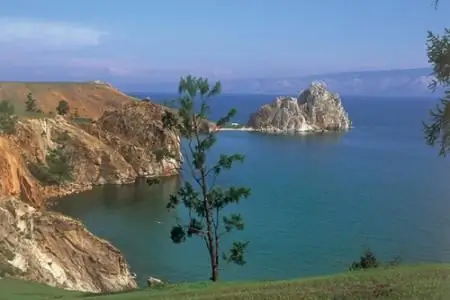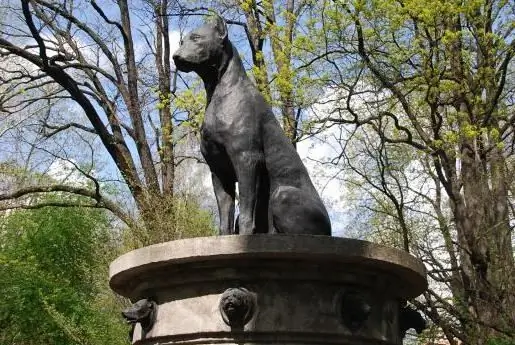- Author Harold Hamphrey [email protected].
- Public 2023-12-17 10:06.
- Last modified 2025-01-24 11:10.
Alexander Nevsky was born in Pereslavl-Zalessky in 1220. The Grand Duke of Novgorod, Vladimir and Kyiv was very early involved in political events and began to take a direct part in various battles. So, for example, during the Battle of the Neva he was only twenty years old, and he participated in the Battle of the Ice at the age of twenty-two. The prince belongs to a small number of those truly great people of Russia, whose activities not only had a great influence on various peoples and countries, but changed them in many ways, and also set the course of Russian history for many decades to come. Subsequently, Alexander Nevsky was officially canonized by the Orthodox Church and elevated to the rank of faithful at the Moscow Cathedral, which took place in 1547.
Monument to Alexander Nevsky

The Prince of Novgorod and Kyiv occupies a special place among a fairly large number of sacralized characters of one or another Russian period. According to the latest polls, this is one of the most popular people in ancient Russian history. Before our compatriots, he appears as an uncompromising fighter for independence, a defender of the Fatherland, who devoted his whole life to protecting the inviolable borders of the Motherland. At the same time, the tradition of honoring the Grand Duke was laid down by the successors of Peter I, who organized a number of special official events. It was thanks to the latter that the image of Nevsky as the defender of the Russian land began to be fixed in historical memory. The tradition of veneration, contrary to the officially established ideology, was continued in the Soviet period. In the postwar years, monuments to Alexander Nevsky began to be actively erected in many cities. In Russia today there are already about twenty of them.
Monument in St. Petersburg
The Grand Duke, along with the last Tsar of All Russia Peter I, is the spiritual patron of the Northern capital of Russia. The emperor himself realized that he owed access to the B altic Sea to none other than Alexander Nevsky. By decree of the tsar, the relics of the prince were transferred to the banks of the Neva from Vladimir, where they were at that time. Some time after this event, the Alexander Nevsky Lavra began to be officially considered the spiritual center of the Northern capital. The monument to the prince is set just opposite the entrance to this monastery, located on the embankment of the Monastyrka River.
Description of the monumentin St. Petersburg

The monument was designed by the Soviet sculptor Valentin Kozenyuk. A monument to Alexander Nevsky was erected in St. Petersburg on May 9, 2002. The pedestal of the monument is made of such natural material as pink granite, and the figure of the prince sitting on a horse is cast in bronze. At the same time, the monument forms a single ensemble with the sculpture of the Bronze Horseman. One of them is located at the end of Nevsky Prospekt, next to St. Isaac's Cathedral, and the second - at the beginning of the avenue - as if protects the Alexander Nevsky Lavra. Separately, it should be said about the image of the Grand Duke, which in this case is collective. So, for example, the sovereign gesture of the hand symbolizes the cause of the sovereign building of Russia, the horse acts as a symbol of heroism and Russian power. Speaking about what other monuments to Alexander Nevsky are in St. Petersburg, one should definitely mention the Alexander Nevsky Bridge, as well as the Alexander Nevsky Temple, located in Krasnoye Selo. Both of them represent the cultural and historical heritage of the Northern capital.
Monument in Pskov
The monument to Alexander Nevsky in Pskov is located just outside the city, on a mountain called Sokolikha. It was installed in honor of one of the most famous exploits of the Grand Duke - the defeat of the Teutonic Knights during the battle that took place on the ice of Lake Peipus. The famous massacre took place on April 5, 1242. It was on this day that the troops, led by the prince of Vladimir and Novgorod, successfully defeated the army in such a waycalled the Livonian Order. The Monument to Alexander Nevsky was erected in Pskov in 1993.
Description of the monument in Pskov

The authors of the sculpture were Honored Artist of the RSFSR, Soviet sculptor Iosif Ivanovich Kozlovsky and Honored Architect of the RSFSR Pyotr Semenovich Butenko. The monument is a rather powerful monument made of bronze. The height of the sculpture is almost thirty meters, and the weight is more than one hundred and sixty tons. The bronze composition depicts the Grand Duke, sitting on a horse and surrounded by Russian warriors. The massiveness of the monument is intended to emphasize the indivisibility and unity of all Russia, as well as highlight the spiritual power of the Russian land in a special way. Separately, it should be said that the place on which the monument to Alexander Nevsky was erected was not chosen by chance. According to legend, at the end of the Battle of the Ice, the Grand Duke, before leaving for Moscow, visited Pskov. It was here that he left the widely known so-called parting letter "Alexander's letter".
Monument in Novgorod

The monument to Alexander Nevsky in Novgorod was erected in the winter of 1985. It happened on the eve of the fortieth anniversary of the Victory in the Great Patriotic War and on the day of the forty-first anniversary of the liberation of the city from the German invaders. Every year in April, near this monument, located on the embankment, a rally is held dedicated to the anniversary of the victory of the troops of Alexander Nevskyon Lake Peipsi. In addition, it is worth noting that this is far from the only monument in honor of the Prince of Vladimir and Novgorod, which Veliky Novgorod can offer. The monument to Alexander Nevsky is also located on the square in front of the Church of Saints Boris and Gleb, not far from the Church of St. John the Evangelist. In addition, in memory of the famous commander, a bust was installed in the city in front of the railway station and a small high relief on the building of the latter. This is one of the main attractions, and all this can be seen in many city photos. The monument to Alexander Nevsky is very revered here, and this is due to the fact that the centuries-old history of the city is closely intertwined with the name of the Grand Duke. This is also evidenced by the monument erected in the Novgorod Kremlin in honor of the Millennium of Russia, where among the most important statesmen one can meet the stately figure of Alexander Nevsky.
Monument in Kursk

Speaking about where the most famous monuments of Russia are located (photos of most of them can be seen here), installed in honor of the great commander, it is impossible not to mention the city of Kursk. The monument is located in the park named after May 1, almost in its very center. The grand opening of the sculpture took place in October 2000. A monument to Alexander Nevsky was created in Kursk by Russian sculptor Vyacheslav Mikhailovich Klykov.
Monument in Vladimir

The bronze monument to the great commander was installed in Vladimir inpark named after A. S. Pushkin, near the statue of Vladimir the Baptist. Alexander Nevsky was Prince of Vladimir for eleven years and was subsequently buried in the Cathedral of the Theotokos-Rozhdestvensky Monastery. However, in 1723 the last Tsar of Russia, Peter I, ordered his relics to be transported to St. Petersburg. This monument was erected in Vladimir in 1967. At the same time, there is an opinion that this rather modest monument to Prince Vladimir and Novgorod is a stone copy of the bronze sculpture of Alexander Nevsky - the work of the famous Moscow sculptor and artist Sergei Mikhailovich Orlov, located in the birthplace of the great commander in the city of Pereslavl-Zalessky.
Monument in Alexandrov
The monument to Alexander Nevsky can also be found in the city of Alexandrov, Vladimir Region. Here the monument is located next to the Nativity Cathedral, in the open air. It was installed in 2013, but according to the residents of the city, they have long wanted to perpetuate the memory of the great commander. Moreover, Alexandrov was once named in honor of Alexander Nevsky. A huge contribution to the process of installing the monument was made by the philanthropist Viktor Kirillov. He prepared the necessary foundation for the monument, provided four tons of marble natural stone for the pedestal, fully paid for the production of bronze sculpture at the Smolensk factory, and also gathered workers for the installation of the monument.
Monument in Rostov-on-Don

Monument to Prince Novgorod andKievsky is located in Rostov-on-Don on the territory of the local cadet corps. The bust of the famous commander was installed as part of a large-scale project called the Alley of Russian Glory. On the territory of the building, in addition to the monument in honor of Alexander Nevsky, you can also see monuments in honor of Nakhimov, Skobelev, Ushakov and other famous people. The author and implementer of the Alley of Russian Glory project is Mikhail Leonidovich Serdyukov, who has been heading the sculpture workshop for more than ten years. The bust of the commander is a gift from him to the cadet corps. However, this is far from the only monument to Prince Vladimirsky erected in Rostov-on-Don. There is also a redoubt of St. Alexander Nevsky. It is located in the First May Park, located on Bolshaya Sadovaya Street. This sculptural structure is a battlement wall, which (according to the ideas of the artists) symbolizes the protection of the city. In addition, here you can see two coats of arms, one of which belongs to Rostov-on-Don, and the second - to Alexander Nevsky himself. Next to the redoubt is a cannon, which personifies the weapon, which at that time was the most powerful and most in demand. Like most of the other monuments erected in Rostov-on-Don, this monument to the famous commander is designed to support the memory of the defenders of the Motherland and those many difficult trials that the soldiers of those eras went through. According to the authors of the project, this is necessary for the city to develop and grow today, doing only peaceful things.
Monument in Moscow
When looking at the monuments to Alexander Nevsky in Russia, it is necessary to mention the church of the Holy Prince in Kozhukhov. This is an Orthodox church built in the Yuzhnoportovy district of the capital. This temple belongs to the Danilovsky deanery of the Moscow diocese. The prince of Novgorod and Kyiv, canonized as a saint, has for many years been considered the heavenly patron of the Orthodox army. The Alexander Nevsky Cathedral was founded in Kozhukhovo on May 5, 2005, on the eve of the 60th anniversary of Russia's victory in the Great Patriotic War. This church is two-tiered and has two thrones. The upper one is lit in honor of Alexander Nevsky, and the lower one is in honor of the monks Oslyabi and Peresvet - the heroes of the Battle of Kulikovo.






